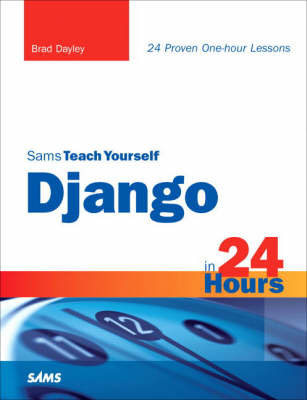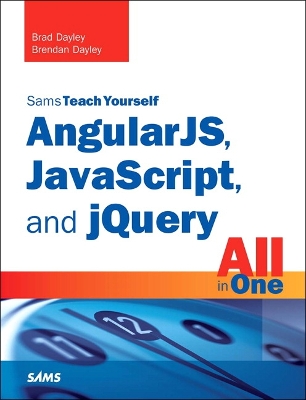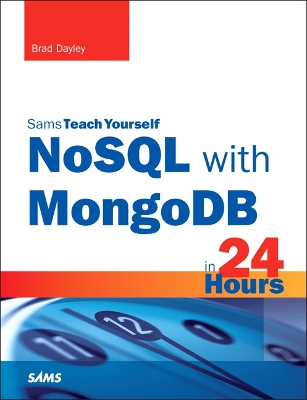Sams Teach Yourself
3 total works
In just 24 lessons of one hour or less, you will be able to build full-featured production websites using Django, the powerful web development framework based on Python.
Designed for experienced website developers who have at least some familiarity with the Python programming language, this book uses a straightforward, step-by-step approach. Each lesson builds on the previous ones, enabling you to learn the essentials of implementing the Django framework on a website from the ground up.
Step-by-step instructions carefully walk you through the most common Django tasks.
Q&As, quizzes, and exercises at the end of each lesson help you test your knowledge.
Notes and tips point out shortcuts and solutions.
Learn how to…
- Install and configure the Django web development framework
- Cleanly separate data, logic, and view layers
- Implement site interfaces with build templates and views
- Utilize templates and views to store, access, and retrieve data
- Use the Django forms library
- Define custom tags and filters to minimize coding
- Secure sites with registration, authorization, logins, and permissions
- Manage sessions and cookies
- Implement middleware for request and response handling
- Create sitemaps to inform search engines of your content
- Internationalize your site
- Optimize performance with caching
- Deploy Django in multiple configurations
- Maintain sites with Django’s administrator interface
Introduction 1
Part I: Creating the Website Framework
Hour 1: Understanding Django 7
Hour 2: Creating Your First Website 19
Hour 3: Adding Models and Objects to Your Website 37
Hour 4: Creating the Initial Views 63
Part II: Implementing the Website Interface
Hour 5: Using Data from the Database in Views 81
Hour 6: Configuring Web Page Views 103
Hour 7: Implementing Django Templates to Create Custom Views 117
Hour 8: Using Built-in Template Tags to Enhance Views 139
Hour 9: Using Built-in Template Filters to Enhance Views 155
Hour 10: Adding Forms to Views 185
Hour 11: Using Views to Add and Update Data in the Database 209
Hour 12: Utilizing Generic Views 231
Hour 13: Advanced View Configurations 269
Part III: Implementing a Full-Featured Website
Hour 14: Managing Site Users 295
Hour 15: Adding Website Security 313
Hour 16: Managing Sessions and Cookies 333
Hour 17: Customizing Models in the Admin Interface 347
Hour 18: Customizing the Admin Interface 365
Part IV: Implementing Advanced Website Components
Hour 19: Implementing Middleware 383
Hour 20: Internationalization and Localization 407
Hour 21: Creating Sitemaps 423
Hour 22: Implementing Multiple Websites 437
Hour 23: Configuring Caching 451
Hour 24: Deploying Django 465
Appendixes
Appendix A: Django Resources 477
Appendix B: Django Form Field Objects 481
Appendix C: Formatting Dates and Times 491
Index 493
AngularJS, JavaScript, and jQuery All in One, Sams Teach Yourself
by Brad Dayley and Brendan Dayley
Learn AngularJS, JavaScript and jQuery Web Application Development In just a short time, you can learn the basics of the JavaScript language, jQuery library, and AngularJS framework – and find out how to use them to build well-designed, reusable components for web applications. Sams Teach Yourself AngularJS, JavaScript, and jQuery All in One assumes absolutely no previous knowledge of JavaScript or jQuery. The authors begin by helping students gain the relevant JavaScript skills they need, introducing JavaScript in a way specifically designed for modern AngularJS web development. Each short, easy lesson builds on all that's come before, teaching new concepts and techniques from the ground up, through practical examples and hands-on problem solving. As you complete the lessons in this book, you'll gain a practical understanding of how to provide rich user interactions in your web pages, adding dynamic code that allows web pages to instantly react to mouse clicks and finger swipes, and interact with back-end services to store and retrieve data from the web server. Learn how to:
- Create powerful, highly interactive single-page web applications
- Leverage AngularJS’s innovative MVC approach to web development
- Use JavaScript in modern frameworks
- Implement JavaScript, jQuery, and AngularJS together in web pages
- Dynamically modify page elements in the browser
- Use browser events to interact with the user directly
- Implement client-side services that interact with web servers
- Integrate rich user interface components, including zoomable images and expandable lists
- Enhance user experience by creating AngularJS templates with built-in directives
- Bind user interface elements and events to the data model to add flexibility and support more robust interactivity
- Define custom AngularJS directives to extend HTML’s capabilities
- Build dynamic browser views to provide richer user interaction
- Create custom services you can integrate into many AngularJS applications
- Develop a well-structured code base that’s easy to reuse and maintain
Now, in just 24 lessons of one hour or less, you can learn how to leverage MongoDB's immense power. Each short, easy lesson builds on all that's come before, teaching NoSQL concepts and MongoDB techniques from the ground up.
Sams Teach Yourself NoSQL with MongoDB in 24 Hours covers all this, and much more:
Learning how NoSQL is different, when to use it, and when to use traditional RDBMSes instead
Designing and implementing MongoDB databases of diverse types and sizes
Storing and interacting with data via Java, PHP, Python, and Node.js/Mongoose
Choosing the right NoSQL distribution model for your application
Installing and configuring MongoDB
Designing MongoDB data models, including collections, indexes, and GridFS
Balancing consistency, performance, and durability
Leveraging the immense power of Map-Reduce
Administering, monitoring, securing, backing up, and repairing MongoDB databases
Mastering advanced techniques such as sharding and replication
Optimizing performance


